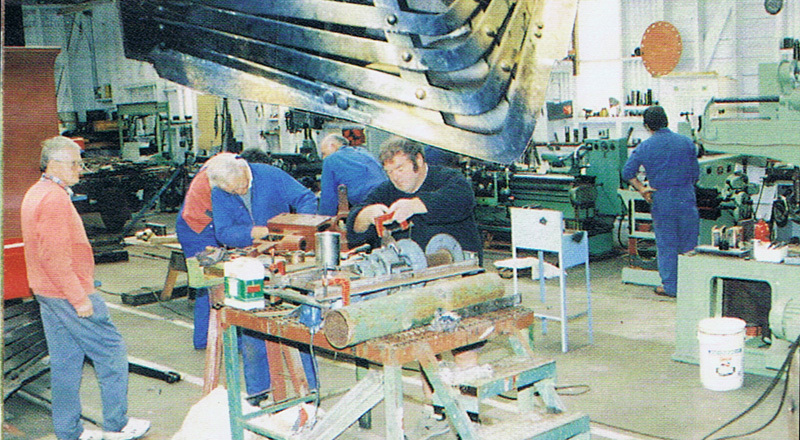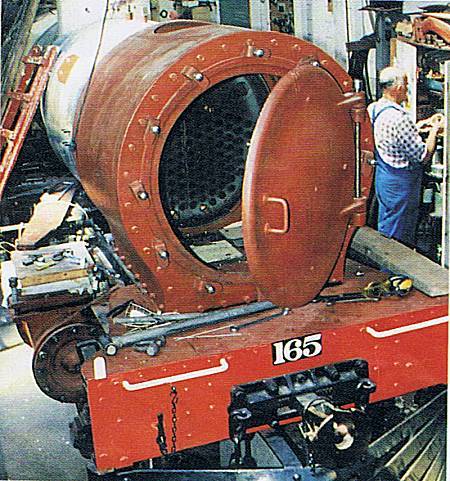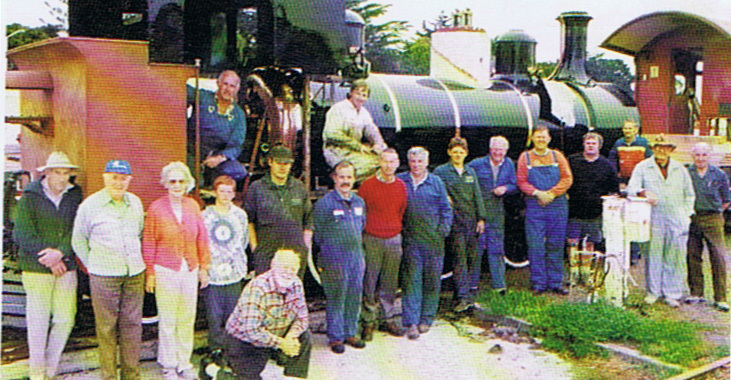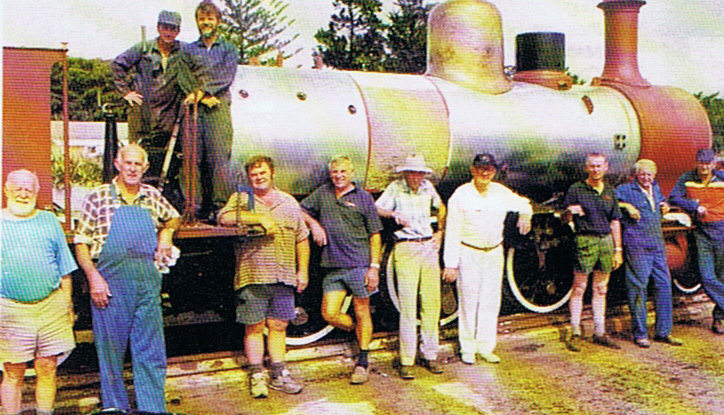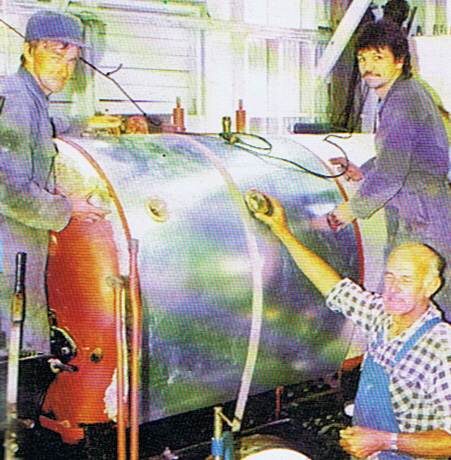Wa165 History
Building of Wa165
The Gisborne Vintage Railway group was founded in 1985 when it began planning the acquisition and restoration of the steam engine known as Wa165, one of six Wa class locomotives that worked out of the Gisborne rail station between 1910 and 1942. Built in 1897, Wa165 was the first locomotive to roll out of NZ Rail’s Hillside Workshops in Dunedin and operated in the Gisborne region for 30 years from 1911.
NZ Rail’s Wa locomotives were a class of tank locomotive and 11 were built in-house at the Addington Workshops in Christchurch and at Hillside between 1892-1903. A tank locomotive, or tank engine, is a steam locomotive that carries its water in an on-board water tank instead of having a separate tender coupled to the engine. The class originated in about 1880 and they were mostly used for industrial work, and later for shunting and short distance main line haulage duties.
Wa165 was the first such tank engine to be built at Hillside and it has the strongest connection to the Gisborne region of all the others in the Wa class. It was put into service at Wellington in April 1898, transferred to the Palmerston North depot in 1899 for 10 years and then moved to work in Taihape in 1910. In early 1911 it went south to the Petone workshops for an overhaul prior to being transported by ship to Gisborne in July of that year.
![Workshop yards at the Hillside Railway Workshops in Dunedin [1925], Ref; APG-1627-1/2-G, Alexander Turnbull Library, Wellington, New Zealand.](/images/595141/Hillside-Railway-Workshops-2.width-800.jpg?v=0.8145732416270575)
Workshop yards at the Hillside Railway Workshops in Dunedin [1925], Ref; APG-1627-1/2-G, Alexander Turnbull Library, Wellington, New Zealand.
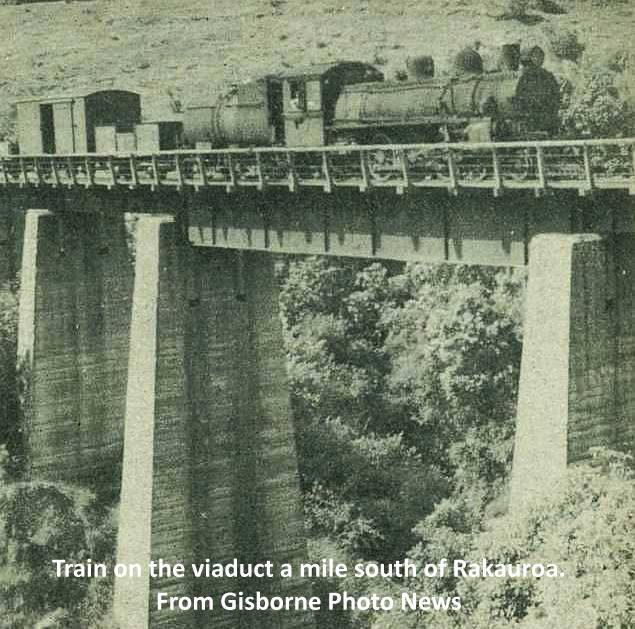
Train on the viaduct a mile south of Rakauroa. From Gisborne Photo News
Wa165 in Gisborne
Due to its isolation, Gisborne had its own stand-alone railway line linking the city with a station 78km north-west of Gisborne at the settlement of Motuhora in the foothills of the steep Raukumara Range.
Wa165’s primary tasks were to cart road metal back to Gisborne from the nearby Motuhora quarry and also timber from the native forests of the Motu wilderness. Wa165 did most of its work on the Motuhora Branch for the next 30 years.
Here is a great article about the Motuhora Branch line
A map of the Gisborne - Motuhora Branch line showing the locations of stations, tunnels, the gradients and other information is available here.
A long-standing plan to continue the line north across the divide to link with Rotorua was eventually abandoned and the Motuhora branch line was closed in March 1959. The expensive nature of the works required to provide a descent to the Bay of Plenty deterred politicians from authorising any further extension of the line.
Wa165 remained in the Gisborne area until the rail line south via Napier was eventually opened in 1942, finally linking the region with the national rail network. With a link to the south, the locomotive was transferred to be based at the Napier railway station but continued to reappear in Gisborne from time to time on shunting duties.
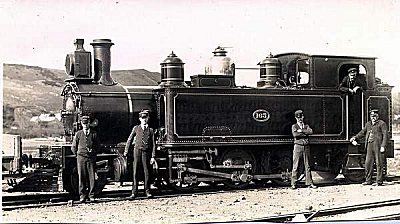
Wa165 in its prime
Wa165 leaves Gisborne
In 1943 Wa165 cut its ties with Gisborne for what would be the next 42 years, when it was dispatched further south to the Hutt Railway Workshops at Petone for its final 2-6-2T class overhaul. In 1946 it was transferred north to be based at the Frankton Junction rail yards near Hamilton from where the engine was sent regularly for shunting duties at stations at Putaruru, Huntly and Te Kuiti.
Between 1951 and 1952 Wa165 was loaned out to the Mines Department at Rotowaro – a small coal mining township approximately 10km west of Huntly – while the mine’s locomotive was out of action for an overhaul. For the next few years, it carried out general shunting duties around Frankton until in 1957 when, in semi-retirement, the ageing locomotive was confined to the daily coal shunt.
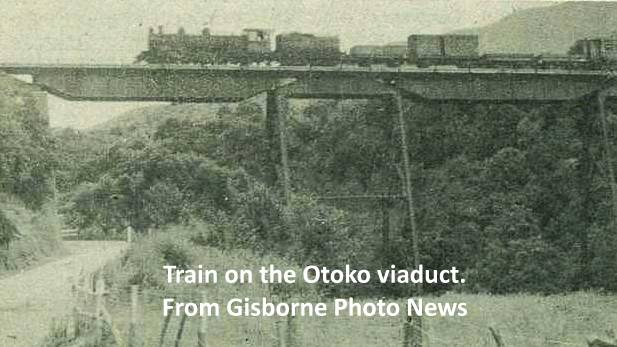
Train on the Otoko viaduct.
From Gisborne Photo News
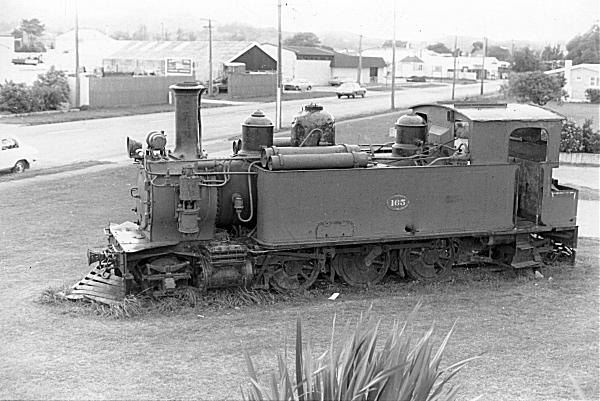
Wa165 retires and comes to Gisborne
Wa165 was withdrawn from service in 1959, and on 25th August 1961, it was finally written off the NZ Rail books while in the process of being sold as a museum piece to the Gisborne Junior Chamber of Commerce in May of that year.
A year earlier, a member of the Chamber had discovered Wa165 slowly decaying on a railway siding at Frankton known as ‘Rotten Row’. After research revealed that the engine had spent 31 of its 62 working years on the old Motuhora line north of Gisborne, it was considered historically important that it be returned to Gisborne to be put on show as a stationary exhibit.
The locomotive was purchased from New Zealand Railways for the sum of 200 pounds which was its scrap value at the time. Raising that sum of money was not a simple task for the group, but on 3rd March 1961 a deposit of 50 pounds was handed over to secure the purchase, with the final payment being made two months later.
During the time that negotiations were taking place, Wa165 had been cleaned up with a steam hose, all axles and bearings oiled and greased, connecting and eccentric rods removed (necessary when running a dead engine) and prepared for the 497 mile haul back to Gisborne. The veteran Wa class 2-6-2 T locomotive No.165 arrived back at the Gisborne Railway Station at midday on 26th May 1961 having travelled from Frankton south to Palmerston North and then north to Napier and on to Gisborne. It was polished up and put on static display at the Gisborne Industries Fair in mid-June of that year.
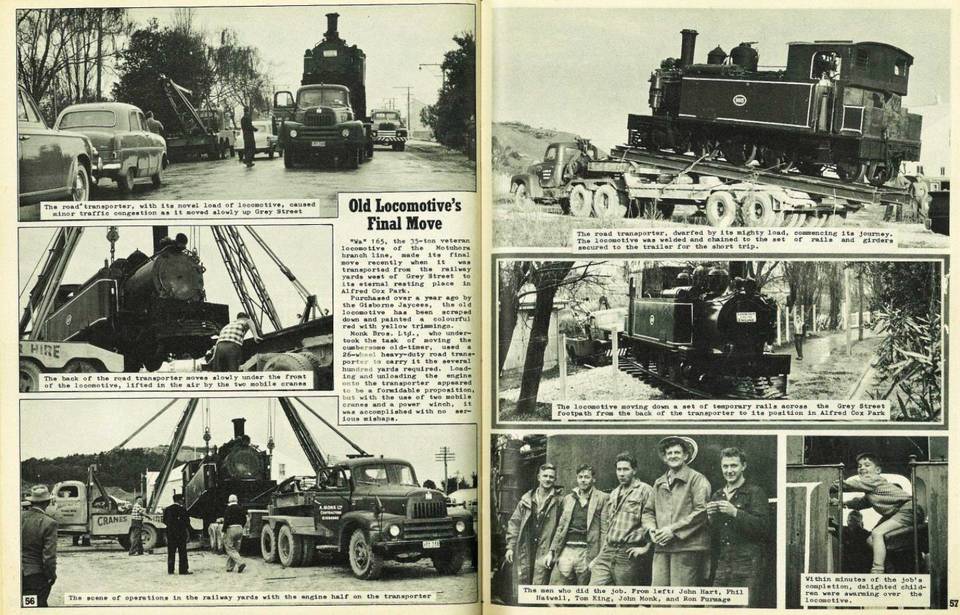
Photo News 12 July 1962
Wa165 on display
During the fair, Wa165 was parked up on an unused piece of track at the Gisborne Railway Station’s demolition yard where rails and sleepers, bridge spans and other materials salvaged from the defunct Gisborne-Motuhora line were stored awaiting disposal and attracted a great deal of attention. It was ironic that Wa165 should be displayed in the same yard containing the now disused rails that she steamed over in her heyday.
When plans were underway to bring the locomotive back to Gisborne, the Gisborne City Council agreed to make a permanent site available for the veteran steam engine. After 12 months of deliberation, the promotional group Greater Gisborne Inc came to the fore and offered the Jaycees a piece of land on Alfred Cox Park in Grey Street, beside what was then the Gisborne skating rink and opposite what is now the Visitor Information Office. Having been sandblasted and painted bright red by this time, Wa165 was moved there in July 1962 on the back of a 26-wheel truck. There it remained for the next six years, quietly deteriorating, with a generation of Gisborne children excited to have a real-life tank engine to play on.
In 1968 the engine was moved to the recently created Young Nicks Playground in Awapuni Road, a site near Midway Beach open to salt-laden sea air — which in hindsight was not a wise move for the preservation of 38-tonnes of vintage locomotive steel. However, there Wa165 remained as a playground toy for the next 18 years, slowly rusting away.
In July 1968 the Gisborne City Council received a request from a Hamilton group seeking the acquisition of Wa165. The Hamilton group pointed out that a similar locomotive, Wa68, which had also ended its working life to become a stationary exhibit in Napier, also close to the sea, had become a heap of corroded metal, a danger to children and finished up as scrap iron. The request was turned down by the Gisborne Council who stated that the engine belonged to Gisborne, and would remain in Gisborne. By this time Wa165 was the sole survivor of its class out of the 11 that were built between 1892 and 1903.
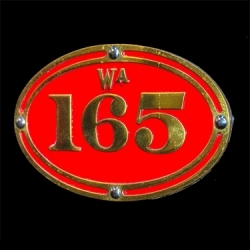
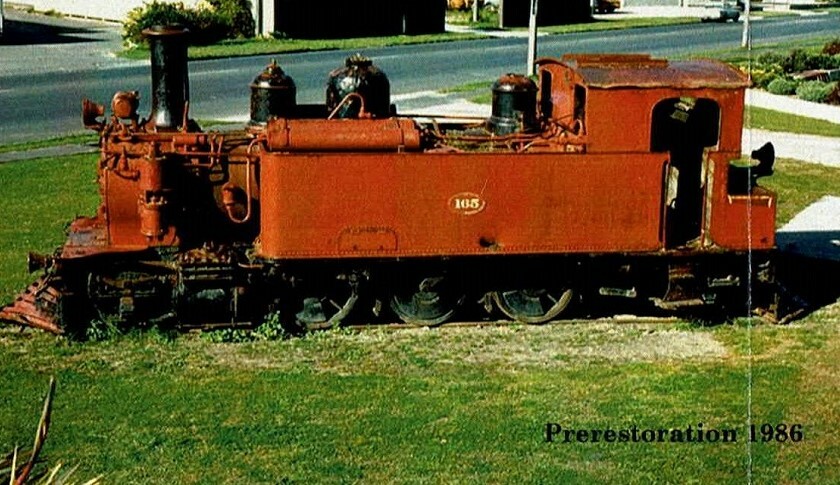
Wa165 gets saved
While it remained at the children’s playground there were those who began to realise the locomotive’s historic credentials and in October of 1985 a group of vintage rail enthusiasts formed the Gisborne City Vintage Railway Society, with the aim of rebuilding Wa165 to its original 1897 condition.
On 5th April 1986, Wa165 was water-blasted ready for its next journey and two weeks later it was hoisted by a Monk Brothers’ crane and moved to a shed at M.E. Jukes & Son’s yard in Stanley Road. Once undercover Wa165 was dismantled bolt by bolt, piece by piece, with all the parts catalogued and recorded before storage, with vital components being stored in drums of oil. On examination many parts were missing and others beyond repair. One of these was the boiler.
The frame was sandblasted and painted in September of 1987. The locomotive’s bare frame was then trucked to the disused NZR Workshops at the Gisborne Railway Station in 1988 where more space and facilities were available to begin the task of restoration and reassembly. The wheels were sent to NZR Workshops in Auckland to be machined in May 1990 and then to the Hutt Workshops at Petone to get retyred at the end of 1990.
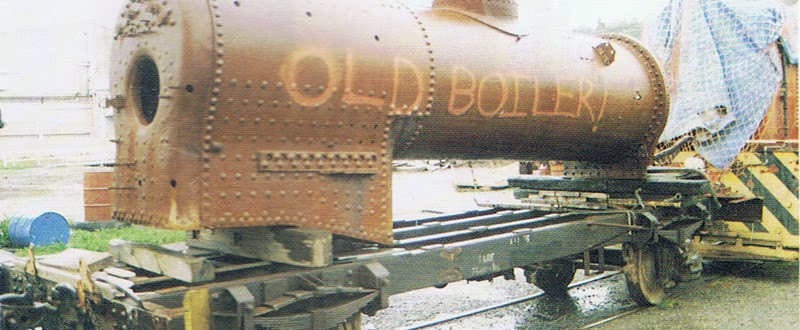
After much debate, Dispatch Engineering in Greymouth was given the task of making a new boiler, the first all-welded boiler for a steam locomotive to be made in New Zealand. This finally arrived in June 1993 and was lifted onto the framework, cladding was done and all the gear installed so that a stationary test firing could be carried out for a boiler inspection on 25th October 1997.
Wa165 back on track
The job of putting Wa165 together piece-by-piece took a further two years and then on 29th November 1999, NZ Railways inspectors took the fully restored Wa165 out for its first test run. Nearly a year later on 22nd October 2000, at 12:30pm Wa165 steamed away from the Gisborne railway station for its first public outing, carrying 100 passengers in two carriages (also restored by the Gisborne City Vintage Railway) to Muriwai and back.
In 2012 KiwiRail announced that it was mothballing the Napier-Gisborne section of the Palmerston North-Gisborne Line, due to the cost of repairing storm damage to the line. This put the future of the Gisborne City Vintage Railway in question.
In 2013 the Gisborne City Vintage Rail group prepared a business case to take over the lease of the line from KiwiRail. The plan included leasing 17km of track from Gisborne to Muriwai for the Gisborne City Vintage Railway to operate steam engine Wa165 for public excursions from the Gisborne Railway Station. In addition to paying the lease, the group agreed to maintain that section of the line including all of the bridges and tunnels.
Currently further storm damage to the track at Beach Loop is preventing Gisborne City Vintage Railway from operating south of Muriwai.
Gisborne City Vintage Railway runs charter and public excursions, mainly from October to June.
A pamphlet summarising the above is available here.
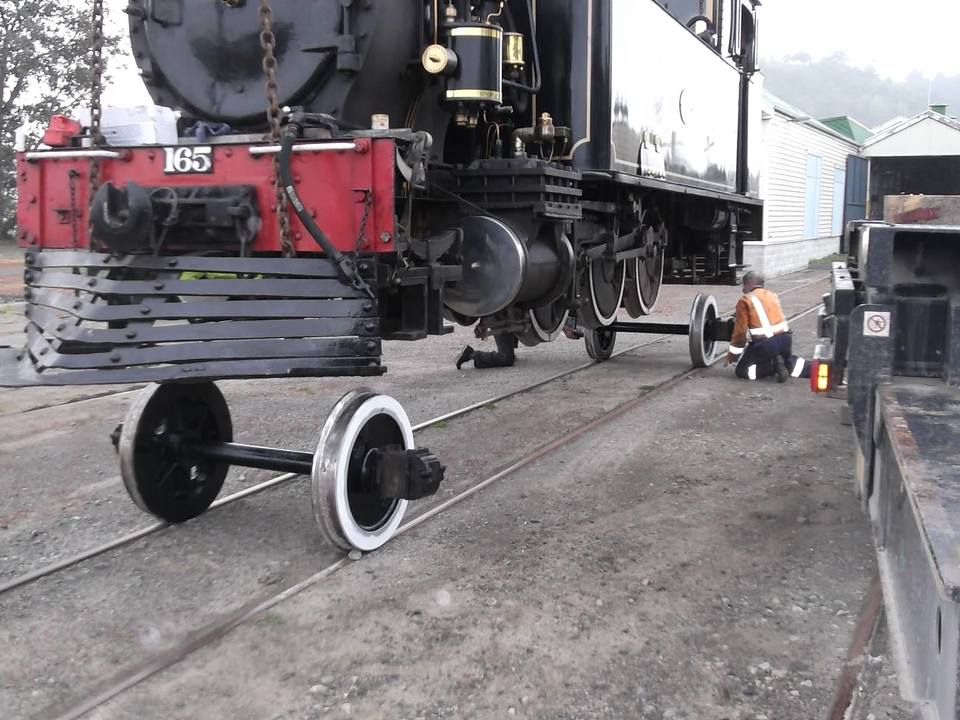
Bookings
Boarding the Train
The train leaves from the Gisborne Railway Station. Please arrive 15 minutes before the departure time shown.Contact Us
info@gcvr.org.nz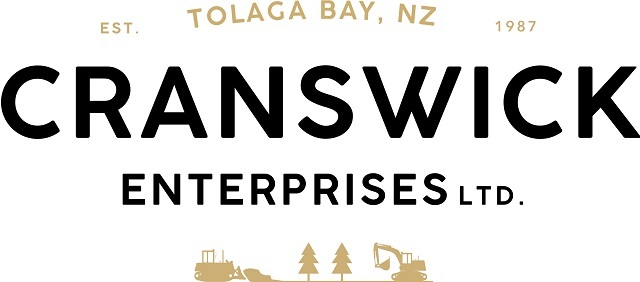
|
© Copyright Gisborne City Vintage Railway - GCVR
- Site map
|


